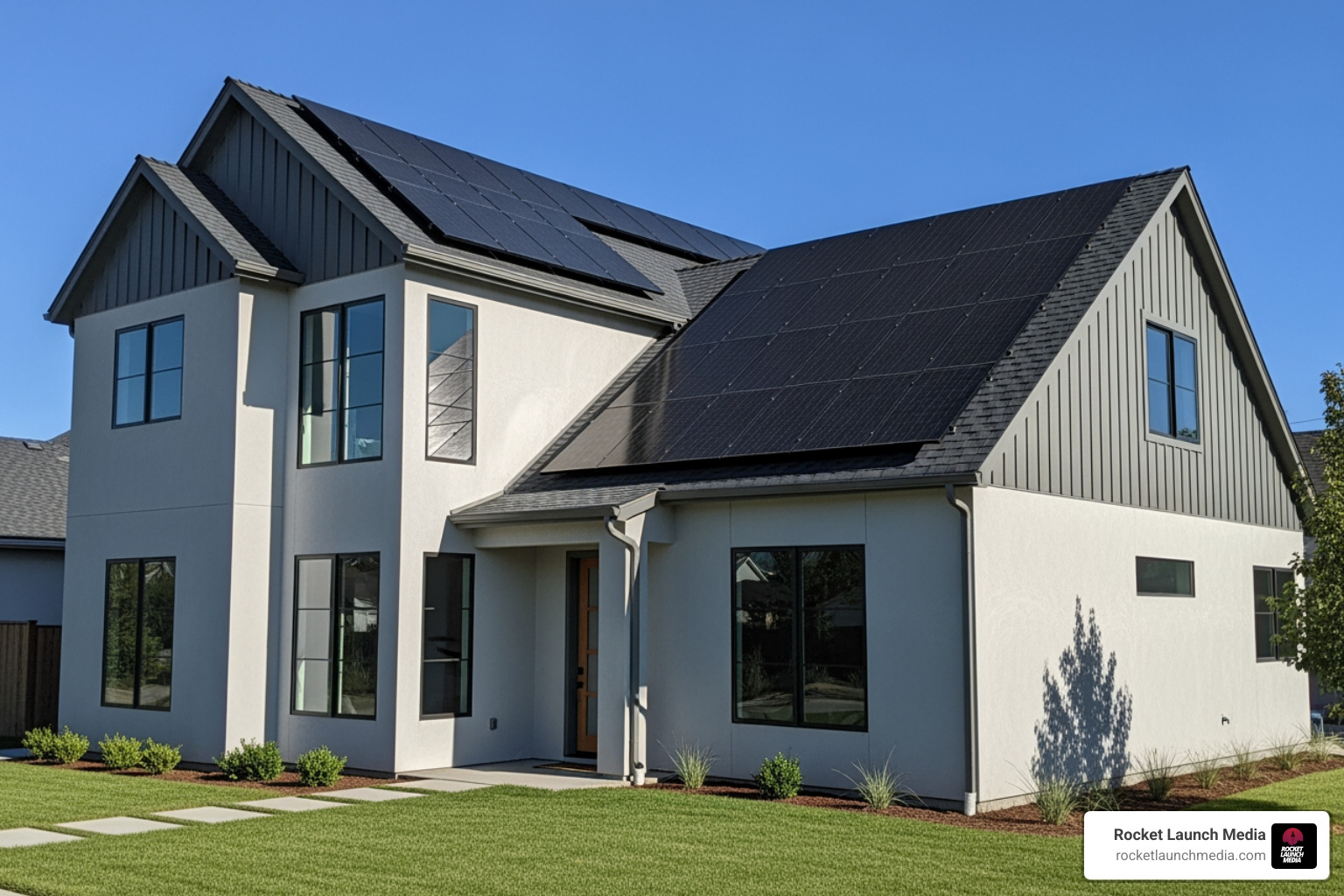Contractor Marketing Strategy: 5 Simple Steps for Success
Why a Contractor Marketing Strategy is Essential for Your Business
If you’re looking to boost your contractor business, Contractor marketing strategy is the key. This process involves identifying your ideal clients and using various digital tools to bring them closer to your services. Here are the essential steps you’ll need:
- Identify your target audience
- Optimize your website for conversions
- Leverage social media marketing
- Use email marketing
- Implement local SEO and directory listings
Marketing is not just about selling—it’s about building relationships and trust. When people know more about your business, they become familiar with your brand. Though they might not hire you immediately, they’ll remember your name when they need a contractor.
A solid digital presence makes your business easier to find online. Imagine someone needs repairs after a storm; they’ll first check Google, social media, or review sites. If your business isn’t visible online, you miss out on potential leads. This is where Rocket Launch Media comes in. With our expertise, we help contractors like you increase online visibility, generate more leads, and grow your business.
My name is Ahmed Elmahdy, founder and CEO of Rocket Launch Media. With over a decade of experience in Contractor marketing strategy and empowering more than 500 clients, I am dedicated to helping you excel in the digital age. Follow along, and let’s open up your business’s potential.

Contractor marketing strategy word list:
Step 1: Identify Your Target Audience
Create a Buyer Persona
To effectively market your contractor services, you must first know who you’re targeting. This involves creating a buyer persona—a semi-fictional representation of your ideal client.
Imagine someone like Jim Haul. Jim is 45, married with two kids, and works a white-collar job. He’s in the upper-middle class, making him a prime candidate for your services. Jim values trust and reliability because he doesn’t enjoy working with his hands and wants things done right the first time.
By visualizing Jim every time you create marketing content, you can speak directly to his deeply felt needs. This makes your messaging more impactful and relatable.
“Experienced marketers know that trying to speak to everyone results in meaningfully communicating with no one.”
Understand Customer Behavior
Knowing your audience’s behavior is crucial. What are their search habits? What preferences do they have? What pain points are they experiencing?
For instance, Jim might search for “reliable home contractor near me” or “best contractor for home renovations.” Understanding these search terms helps you tailor your Contractor marketing strategy to appear in his search results.
Key Factors to Consider:
- Search Habits: What keywords do they use?
- Preferences: Do they prefer local contractors? Are they price-sensitive?
- Pain Points: What problems are they trying to solve? Lack of time? Poor past experiences?
By addressing these elements, you can create a more effective marketing strategy that resonates with your target audience.
Next, we’ll explore how to optimize your website for conversions.
Step 2: Optimize Your Website for Conversions
Your website is your digital storefront. To convert visitors into leads, it needs to be optimized for both user experience and search engines. Here’s how to do it:
Key Elements of a Goal-Oriented Website
User Experience Design
A seamless user experience design ensures visitors can easily find what they need. This includes intuitive navigation, fast loading times, and mobile-friendly layouts.
- Simple Navigation: Make it easy for users to find information.
- Fast Loading: Aim for your site to load in under three seconds.
- Mobile-Friendly: Ensure your site looks good on all devices.
Readability
Clear and easy-to-read content keeps visitors engaged. Follow these guidelines:
- Write in short sentences at an 8th-grade level.
- Keep paragraphs 2-4 sentences long.
- Double space between paragraphs.
- Use clear and concise headlines like “Affordable Roof Repair and Replacement Services.”
Clear Call to Action
Identify what you want visitors to do and make it obvious.
- Include buttons that call people to action, like “Schedule My Free Site Survey!”
- Place your call to action on every page, including blog posts and the homepage.
Trust-Building Techniques
Build trust by showcasing your credibility.
- Include testimonials from satisfied customers.
- Display badges or certifications to show expertise.
- Feature any awards or publications your business has been recognized in.
SEO Best Practices
Keyword Research
Find out what terms your audience is searching for. Use tools like Google Keyword Planner to identify high-intent keywords.
On-Page SEO
Optimize each page for search engines.
- Title Tags: Keep them under 60 characters and include your main keyword. For example, “Roofing Contractor in Miami | Expert Roof Repair.”
- Meta Descriptions: Write compelling summaries around 150 characters long, including a call-to-action.
- Header Tags: Use H1, H2, and H3 tags to structure your content. Include keywords in these headers.
- Internal Linking: Link to other relevant pages on your website. Use descriptive anchor text.
- Images: Optimize images with descriptive filenames and alt text. Compress them for faster loading.
Google Analytics
Use Google Analytics to monitor your website’s performance.
- Track visitor behavior to see what’s working and what’s not.
- Make data-driven changes to improve your conversion rate.
By following these steps, you can create a goal-oriented website that not only attracts visitors but also converts them into leads.
Next, we’ll explore how to leverage social media marketing.
Step 3: Leverage Social Media Marketing
Social media is a powerful tool for connecting with your audience and building your brand. Here’s how to make the most of it for your contractor marketing strategy.
Effective Social Media Strategies
Platform Selection
Choosing the right social media platform is crucial. Each platform has its unique audience and strengths:
- Facebook: Great for reaching a broad audience and sharing various content types.
- Instagram: Ideal for visual content and younger demographics.
- LinkedIn: Best for B2B marketing and professional networking.
- Twitter: Useful for real-time updates and engaging with trending topics.
Content Types
Different platforms favor different types of content:
- Facebook: Videos, blog posts, and infographics.
- Instagram: High-quality images and short videos.
- LinkedIn: Professional articles and industry news.
- Twitter: Short updates, links, and hashtags.
Audience Engagement
Engaging with your audience builds trust and loyalty. Respond promptly to comments and messages, and participate in conversations. Host contests and giveaways to encourage participation. Share user-generated content to highlight customer reviews and success stories.
Consistent Branding
Keep your branding consistent across all platforms. Use the same logo, color scheme, and tone of voice. This helps in building brand recognition and trust.
High-Quality Images
Use professional photos to showcase your work. Blurry or low-quality images can turn people away. Platforms like Instagram are highly visual, so quality matters.
Regular Posting
Post regularly to keep your audience engaged. Aim for at least once a week. Use a content calendar to plan your posts in advance.
Paid Social Media Advertising
Targeted Campaigns
Paid ads can help you reach a larger audience. Use Facebook and Instagram’s targeting tools to specify your audience based on location, income, interests, and behaviors.
Audience Segmentation
Create specific campaigns for different target audiences. For example, you might have one campaign for homeowners and another for property managers.
ROI Tracking
Track the performance of your ads to ensure you’re getting a good return on investment (ROI). Use metrics like click-through rate (CTR), conversion rate, and cost per click (CPC).
By leveraging social media effectively, you can improve your brand’s visibility and foster a loyal customer base.
Next, we’ll explore how to use email marketing to nurture leads and drive conversions.
Step 4: Use Email Marketing
Email marketing is a powerful tool for contractors to nurture leads, build relationships, and drive conversions. Let’s dive into how you can leverage email marketing effectively.
Crafting Effective Email Campaigns
Lead Nurturing
Email marketing helps you stay connected with potential clients. By sending regular updates, you keep your business top-of-mind. For instance, share project updates, success stories, or industry news to engage your audience.
Personalized Content
Personalization is key. Use your subscribers’ names and tailor content to their interests. For example, send home renovation tips to homeowners and commercial project insights to business clients. Personalized emails see higher open and click-through rates.
Building an email list starts with capturing emails organically. Use sign-up forms on your website, offer free guides, or run contests. Avoid buying email lists as they often contain uninterested parties and can harm your reputation.
Valuable Content
Your emails should provide value. Share tips, industry news, or exclusive offers. For instance, send a monthly newsletter with home maintenance tips or seasonal promotions. This keeps your audience engaged and looking forward to your emails.
Promotions
Promotions can drive conversions. Offer discounts, special deals, or early access to services. For example, a limited-time discount on kitchen renovations can spur action.
Segmentation
Segment your email list based on demographics, behavior, or interests. This allows you to send more relevant content. For example, segment by location to send area-specific offers or by past interactions to tailor follow-up emails.
Tools for Email Marketing
Automation Software
Automation tools like Mailchimp or HubSpot can save you time. Set up automated email sequences for new subscribers or follow-up emails for leads who haven’t responded. Automation ensures consistent communication without manual effort.
Analytics
Track the performance of your email campaigns using analytics. Metrics like open rates, click-through rates, and conversions provide insights into what’s working. Use this data to refine your strategy.
A/B Testing
A/B testing involves sending two versions of an email to see which performs better. Test different subject lines, images, or calls to action. For example, see if a “10% Off” subject line gets more opens than “Exclusive Offer Inside.” Use the results to optimize future campaigns.
By crafting effective email campaigns and utilizing the right tools, you can nurture leads and drive conversions for your contractor business.
Next, we’ll explore how to implement local SEO and directory listings to boost your online visibility.
Step 5: Implement Local SEO and Directory Listings
Claim and Optimize Listings
To boost your online visibility and attract local customers, claiming and optimizing your listings on platforms like Google My Business is crucial. This helps you appear in local searches, such as the local SEO 3-pack, which shows the top three businesses for a given query.
Google My Business
Claiming your Google My Business profile is essential. This listing appears when people search for contractors in your area. Make sure to:
- Fill out all the information: Include your business name, address, phone number, and website. Consistent information across all platforms is key.
- Add high-quality images: Showcase your best work. Images of completed projects can attract more clients.
- Encourage customer reviews: Positive reviews improve your ranking and build trust. Respond to all reviews to show you value customer feedback.
Local SEO 3-Pack
Appearing in the local SEO 3-pack can significantly increase your visibility. To improve your chances:
- Optimize your website: Use geo-specific keywords, like “roofing contractor in Austin, TX,” in your titles and content.
- Build local citations: List your business in local directories like Yelp and Angi. Consistent NAP (Name, Address, Phone number) information is vital.
- Acquire local backlinks: Partner with local businesses or bloggers to get backlinks to your site.
Geofencing and PPC Advertising
Geofencing
Geofencing uses GPS or RFID technology to create a virtual boundary around a specific location. When potential customers enter this area, they receive targeted ads. This is highly effective for contractors who serve specific neighborhoods or cities.
Benefits of Geofencing:
- Location-based ads: Show ads to people who are physically near your business or in areas you serve.
- Immediate results: Target people in real-time, increasing the likelihood of immediate action.
- Cost-effective: Focus your ad spend on a specific area, reducing waste.
PPC Advertising
Pay-per-click (PPC) advertising complements geofencing. With PPC, you only pay when someone clicks on your ad, making it a cost-effective way to attract new leads.
Steps to Implement PPC:
- Choose long-tail keywords: Keywords like “home renovation contractors in Harrisburg, PA” attract more qualified leads.
- Set your budget: Decide on your maximum bid per click and stick to it.
- Track ROI: Use analytics to measure the performance of your ads. Adjust your strategy based on what’s working.
By combining local SEO, directory listings, geofencing, and PPC advertising, you can create a powerful contractor marketing strategy that drives local traffic and generates leads.
Next, we’ll answer some frequently asked questions about contractor marketing strategies.
Frequently Asked Questions about Contractor Marketing Strategy
How to do marketing as a contractor?
Marketing as a contractor involves several key strategies to attract and retain clients:
Modern Website: A professional, mobile-friendly website is essential. It should have clear contact information, service descriptions, and a form for quotes or consultations. According to our research, a well-designed website can significantly boost lead generation.
SEO (Search Engine Optimization): Optimize your website for search engines. Use keywords related to your services and location. For example, “kitchen remodeler in Seattle.” This helps your site appear in local search results, driving organic traffic.
Google Business Profile: Claim and optimize your Google Business Profile. Fill out all details, add high-quality images, and encourage customer reviews. This makes your business more visible in local searches.
PPC (Pay-Per-Click) Advertising: Use PPC ads to get immediate traffic. Platforms like Google Ads allow you to target specific keywords and locations. This is cost-effective as you only pay when someone clicks on your ad.
Social Media: Leverage platforms like Facebook, Instagram, and LinkedIn. Post high-quality images of your work, engage with your audience, and run targeted ads. Social media helps build brand awareness and trust.
What are the four types of marketing strategies?
The four main types of marketing strategies are:
Market Penetration: Focus on increasing sales of existing services in your current market. This can be achieved through promotions, discounts, and improving customer service.
Market Development: Expand your services to new markets. For example, if you’re a roofing contractor in one city, consider expanding to nearby cities.
Product Development: Introduce new services to your existing market. If you specialize in bathroom remodels, you might add kitchen remodeling to your offerings.
Diversification: Enter new markets with new services. This is the most risky but can be very rewarding. For example, a general contractor might diversify into commercial construction.
How to get customers as a contractor?
To attract customers, use a combination of online and offline strategies:
Website: Ensure your website is optimized for conversions. Include clear calls-to-action, testimonials, and a portfolio of your work.
Google My Business: Claim and optimize your Google My Business profile. This improves your visibility in local searches and helps potential customers find you easily.
Local SEO: Use local SEO tactics to appear in the local SEO 3-pack. This includes using geo-specific keywords and building local citations.
Social Media: Engage with your audience on social media. Share your projects, customer reviews, and industry tips. This builds trust and keeps your business top-of-mind.
Reviews: Encourage satisfied customers to leave reviews on Google, Yelp, and other platforms. Respond to all reviews to show you value customer feedback. Positive reviews can significantly influence potential clients.
By implementing these strategies, you’ll develop a robust contractor marketing strategy that attracts and retains customers.
Next, we’ll dive into the conclusion of our guide on contractor marketing strategies.
Conclusion
Developing a contractor marketing strategy is essential for growing your business and attracting more clients. Here’s a quick recap of the steps we covered:
Identify Your Target Audience: Create a detailed buyer persona and understand their needs and behaviors. This will help you tailor your marketing efforts to speak directly to your ideal clients.
Optimize Your Website for Conversions: Ensure your website is user-friendly, mobile-optimized, and quick to load. Incorporate clear calls-to-action and trust-building elements like testimonials and case studies.
Leverage Social Media Marketing: Use social media platforms to engage with your audience and drive traffic to your website. Consistent branding and high-quality content are key.
Use Email Marketing: Build and nurture your email list with valuable content and personalized campaigns. Use tools to automate and analyze your email marketing efforts.
Implement Local SEO and Directory Listings: Claim and optimize your Google My Business profile and other online directories. Use local SEO tactics to appear in the local search results and drive more traffic to your site.
Importance of Strategy
A well-thought-out marketing strategy is crucial for standing out in a competitive market. It helps you focus your efforts on the tactics that will yield the best results, saving you time and resources. By understanding your audience and optimizing your online presence, you can attract more qualified leads and ultimately grow your contracting business.
Rocket Launch Media
At Rocket Launch Media, we specialize in PPC, SEO, and social media advertising to drive growth and generate qualified leads. Our unique selling proposition is delivering tangible results like sales and revenue, not just metrics. We’re here to help you create and implement a marketing strategy that works.
Ready to lift your business? Contact Rocket Launch Media today to discuss your marketing needs and start generating more leads.
By following these steps and leveraging our expertise, you can build a robust contractor marketing strategy that sets you apart from the competition and drives your business forward.








